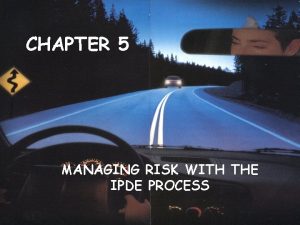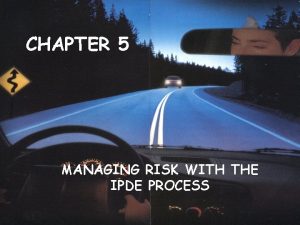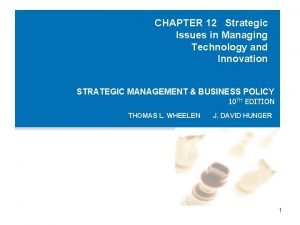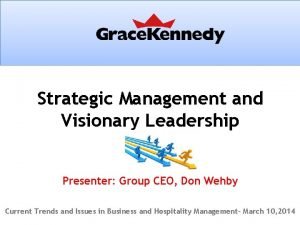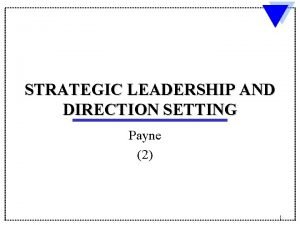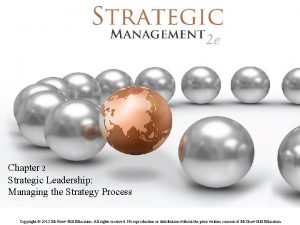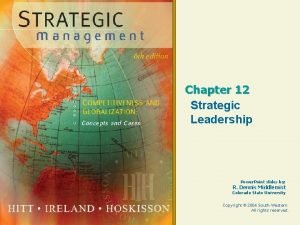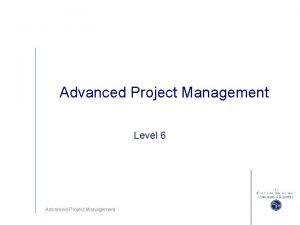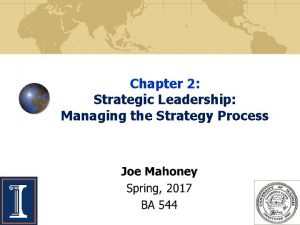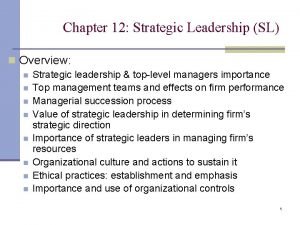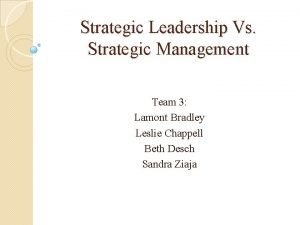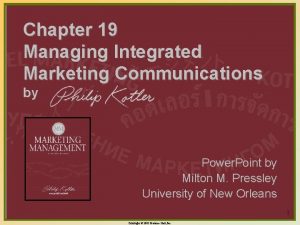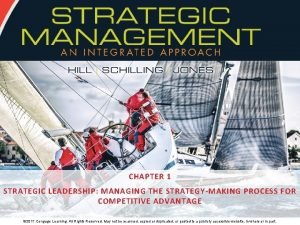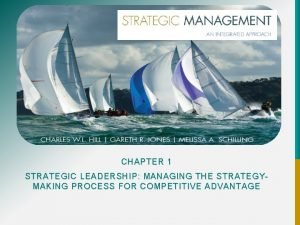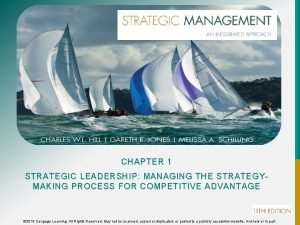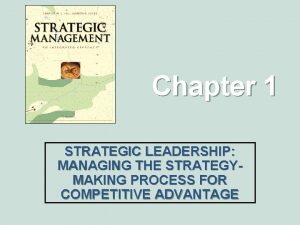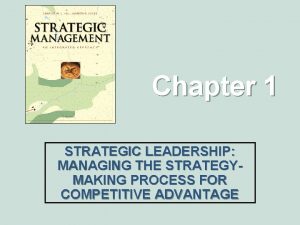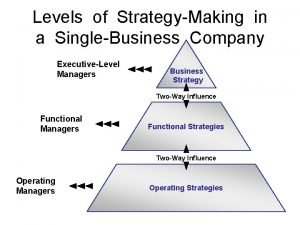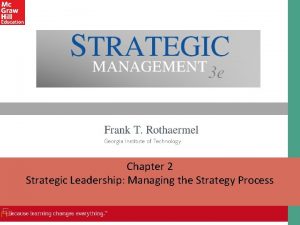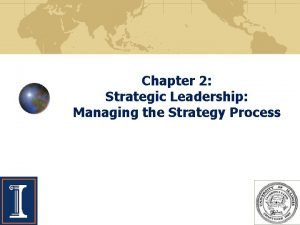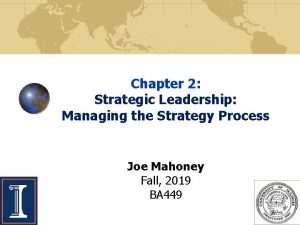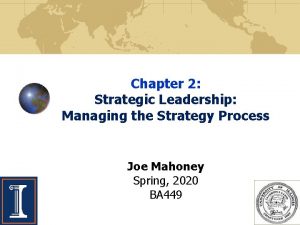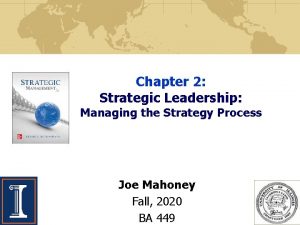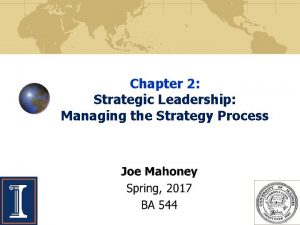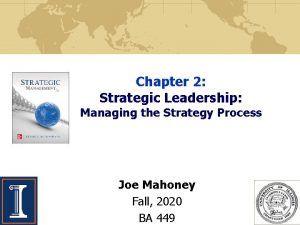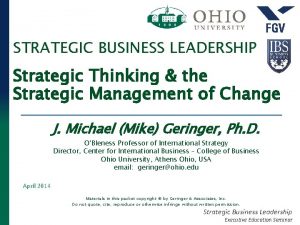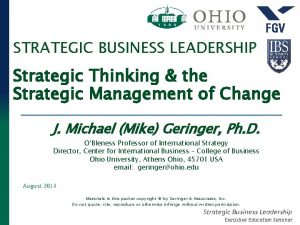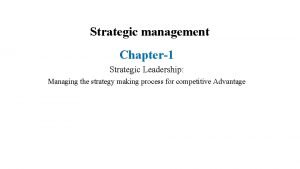Chapter 1 STRATEGIC LEADERSHIP MANAGING THE STRATEGYMAKING PROCESS






















































- Slides: 54

Chapter 1 STRATEGIC LEADERSHIP: MANAGING THE STRATEGYMAKING PROCESS FOR COMPETITIVE ADVANTAGE

Profitability of Walmart & Competitors Figure 1. 1 2010 Cengage Learning. All Rights Reserved. May not be copied, scanned, or duplicated, in whole or in part, except for use as permitted in a license distributed with a certain product or service or otherwise on a password-protected website for classroom use. 1 -2

Why do some organizations succeed while others fail? Strategy- a set of related actions managers take to increase company’s performance. o Strategic Leadership- Effectively managing a company’s strategy-making process o Strategy Formulation- Determining & selecting strategies o Strategy Implementation- Putting strategies into action to improve company’s efficiency & effectiveness 2010 Cengage Learning. All Rights Reserved. May not be copied, scanned, or duplicated, in whole or in part, except for use as permitted in a license distributed with a certain product or service or otherwise on a password-protected website for classroom use. 1 -3

Determinants of Shareholder Value Figure 1. 2 To increase shareholder value, managers must pursue strategies that increase the profitability of the company and grow the profits. 2010 Cengage Learning. All Rights Reserved. May not be copied, scanned, or duplicated, in whole or in part, except for use as permitted in a license distributed with a certain product or service or otherwise on a password-protected website for classroom use. 1 -4

Superior Performance “Maximizing shareholder value is the ultimate goal of profit making companies…” 2010 Cengage Learning. All Rights Reserved. May not be copied, scanned, or duplicated, in whole or in part, except for use as permitted in a license distributed with a certain product or service or otherwise on a password-protected website for classroom use. 1 -5

Differences in Industry Performance Profitability/Profit Growth: Overall performance of industry relative to other industries Company’s relative success in industry compared to competitors 2010 Cengage Learning. All Rights Reserved. May not be copied, scanned, or duplicated, in whole or in part, except for use as permitted in a license distributed with a certain product or service or otherwise on a password-protected website for classroom use. 1 -6

ROI in Selected Industries (2004– 2008) Figure 1. 3 2010 Cengage Learning. All Rights Reserved. May not be copied, scanned, or duplicated, in whole or in part, except for use as permitted in a license distributed with a certain product or service or otherwise on a password-protected website for classroom use. 1 -7

Performance in Nonprofit Enterprises Nonprofit entities= government agencies, universities, charities: o Not in business to make a profit o Still need to use resources efficiently & effectively o Must meet goals o Set strategies to achieve goals and compete with other nonprofits for scarce resources 2010 Cengage Learning. All Rights Reserved. May not be copied, scanned, or duplicated, in whole or in part, except for use as permitted in a license distributed with a certain product or service or otherwise on a password-protected website for classroom use. 1 -8

“A successful strategy gives potential donors a compelling message about why they should contribute. ” 2010 Cengage Learning. All Rights Reserved. May not be copied, scanned, or duplicated, in whole or in part, except for use as permitted in a license distributed with a certain product or service or otherwise on a password-protected website for classroom use. 1 -9

Strategic Managers o Corporate-Level Managers o Oversee development of strategies for whole organization o CEO is principle general manager who consults with other senior executives o Business-Level Managers o Responsible for business unit that provides product/service to particular market o Functional-Managers o Supervise particular function/operation (e. g. marketing, operations, accounting, human resources) 2010 Cengage Learning. All Rights Reserved. May not be copied, scanned, or duplicated, in whole or in part, except for use as permitted in a license distributed with a certain product or service or otherwise on a password-protected website for classroom use. 1 -10

Levels of Strategic Management Figure 1. 4 2010 Cengage Learning. All Rights Reserved. May not be copied, scanned, or duplicated, in whole or in part, except for use as permitted in a license distributed with a certain product or service or otherwise on a password-protected website for classroom use. 1 -11

Strategy-Making Process j Select corporate mission & major corporate goals. k Analyze external competitive environment to identify opportunities/threats. l Analyze organization’s internal environment to identify strengths/weaknesses. Select strategies that: • • • Build on organization’s strengths and correct weaknesses– to take advantage of external opportunities & counter external threats Are consistent with organization’s mission and major goals Are congruent and constitute a viable business model Implement the strategies. 2010 Cengage Learning. All Rights Reserved. May not be copied, scanned, or duplicated, in whole or in part, except for use as permitted in a license distributed with a certain product or service or otherwise on a password-protected website for classroom use. 1 -12

Strategy Formulation & Implementation Figure 1. 5 2010 Cengage Learning. All Rights Reserved. May not be copied, scanned, or duplicated, in whole or in part, except for use as permitted in a license distributed with a certain product or service or otherwise on a password-protected website for classroom use. 1 -13

Criticisms of Formal Planning Model 1) Unpredictability of real world 2) Role lower-level managers can play 3) Many strategies result of serendipity 2010 Cengage Learning. All Rights Reserved. May not be copied, scanned, or duplicated, in whole or in part, except for use as permitted in a license distributed with a certain product or service or otherwise on a password-protected website for classroom use. 1 -14

Intended & Emergent Strategies o Intended/Planned Strategies o o o Strategies organization plans to implement Result of formal planning process Unrealized strategies are unprecedented changes & unplanned events after formal planning complete o Emergent Strategies o Unplanned responses to unforeseen circumstances o Serendipitous discoveries/events emerge that open up unplanned opportunities o Assess emergent strategy fits needs & capabilities o Realized Strategies o Intended strategies put into action & emergent strategies evolve 2010 Cengage Learning. All Rights Reserved. May not be copied, scanned, or duplicated, in whole or in part, except for use as permitted in a license distributed with a certain product or service or otherwise on a password-protected website for classroom use. 1 -15

Emergent & Deliberate Strategies Figure 1. 7 Source: Adapted from H. Mintzberg and A. Mc. Gugh, Administrative Science Quarterly, Vol. 30. No. 2, June 1985. 2010 Cengage Learning. All Rights Reserved. May not be copied, scanned, or duplicated, in whole or in part, except for use as permitted in a license distributed with a certain product or service or otherwise on a password-protected website for classroom use. 1 -16

Strategic Planning in Practice Formal planning has positive impact on performanceshould include current/future competitive environments. o Scenario Planning • Recognizes the future unpredictable • Develops strategies for future scenarios o Decentralized Planning- Functional managers • Avoids ivory tower approach • Corporate-level planners = facilitators 2010 Cengage Learning. All Rights Reserved. May not be copied, scanned, or duplicated, in whole or in part, except for use as permitted in a license distributed with a certain product or service or otherwise on a password-protected website for classroom use. 1 -17

Strategic Decision Making Companies may adopt poor strategies if groupthink or individual cognitive biases allowed to intrude into decision-making process. ØCognitive biases: Rules of thumb result in errors ØGroupthink: Decision makers embark on course of action without questioning underlying assumptions 2010 Cengage Learning. All Rights Reserved. May not be copied, scanned, or duplicated, in whole or in part, except for use as permitted in a license distributed with a certain product or service or otherwise on a password-protected website for classroom use. 1 -18

Chapter 2 EXTERNAL ANALYSIS: THE IDENTIFICATION OF OPPORTUNITIES AND THREATS

Industry “…a group of companies offering products or services that are close substitutes for each other… that satisfy the same basic customer need. ” 2010 Cengage Learning. All Rights Reserved. May not be copied, scanned, or duplicated, in whole or in part, except for use as permitted in a license distributed with a certain product or service or otherwise on a password-protected website for classroom use. 2 -20

Sector “…a group of closely related industries. ” 2010 Cengage Learning. All Rights Reserved. May not be copied, scanned, or duplicated, in whole or in part, except for use as permitted in a license distributed with a certain product or service or otherwise on a password-protected website for classroom use. 2 -21

The Computer Sector: Industries and Segments Figure 2. 1 2010 Cengage Learning. All Rights Reserved. May not be copied, scanned, or duplicated, in whole or in part, except for use as permitted in a license distributed with a certain product or service or otherwise on a password-protected website for classroom use. 2 -22

Market Segments “…distinct groups of customers within a market that can be differentiated from each other on the basis of their distinct attributes and specific demands. . ” 2010 Cengage Learning. All Rights Reserved. May not be copied, scanned, or duplicated, in whole or in part, except for use as permitted in a license distributed with a certain product or service or otherwise on a password-protected website for classroom use. 2 -23

Porter’s Five Forces Model 2010 Cengage Learning. All Rights Reserved. May not be copied, scanned, or duplicated, in whole or in part, except for use as permitted in a license distributed with a certain product or service or otherwise on a password-protected website for classroom use. 2 -24

How the Five Forces Shape Competition “…the stronger each of these five forces is, the more limited is the ability of established companies to raise prices and earn greater profits. ” q. Weak competitive force- viewed as an opportunity as it allows company to earn greater profits q. Strong competitive force- viewed as a threat as it depresses industry profits q. Strength of forces may change as industry conditions change 2010 Cengage Learning. All Rights Reserved. May not be copied, scanned, or duplicated, in whole or in part, except for use as permitted in a license distributed with a certain product or service or otherwise on a password-protected website for classroom use. 2 -25

Risk of Entry by Potential Competitors “…companies… not currently competing in an industry but have the capability to do so. . . ” Barriers include: 1. Economies of Scale – unit costs fall v Cost reductions v Bulk purchase discounts v Cost savings 2. Brand Loyalty = creating customer preferences 3. Absolute Cost Advantages v. New Entrants v Experience, patents, processes v Control of production inputs v Lower financial risks 4. Customer Switching Costs 5. Government Regulation 2010 Cengage Learning. All Rights Reserved. May not be copied, scanned, or duplicated, in whole or in part, except for use as permitted in a license distributed with a certain product or service or otherwise on a password-protected website for classroom use. 2 -26

Rivalry Among Established Companies “…competitive struggle between companies in same industry to gain market share. . . ” Function of: v Industry Competitive Structure- Number/size of companies, consolidated vs. fragmented v Industry Demand Conditions v Growing demand – reduces rivalry v Declining demand – encourages rivalry v Cost Conditions v High fixed costs – profitability leveraged by volume v Slow demand/growth – intense rivalry/lower profits v Exit Barriers v High fixed cost v Write-off assets v Economic dependence v Emotional attachment v Maintain assets v Bankruptcy regulations 2010 Cengage Learning. All Rights Reserved. May not be copied, scanned, or duplicated, in whole or in part, except for use as permitted in a license distributed with a certain product or service or otherwise on a password-protected website for classroom use. 2 -27

Bargaining Power of Buyers “…consumers/end-users who…use product or intermediaries that distribute or retail the products. ” Buyers most powerful when: 1. Suppliers = many small companies, buyers large/few 2. Purchase in large quantities 3. Suppliers depend on buyers for large % of orders 4. Buyers switching costs are low 5. Buyer can purchase from several 6. Buyers supply own needs 2010 Cengage Learning. All Rights Reserved. May not be copied, scanned, or duplicated, in whole or in part, except for use as permitted in a license distributed with a certain product or service or otherwise on a password-protected website for classroom use. 2 -28

Bargaining Power of Suppliers “…provide inputs… in the industry. ” Suppliers most powerful when: 1. Few substitutes 2. Industry not important to suppliers 3. Buyers- purchase large % of orders 4. Buyers experience significant switching costs 5. Suppliers can threaten to enter industry v Produce/supply own product 2 -29 v Buyers cannot threaten to make own inputs 2010 Cengage Learning. All Rights Reserved. May not be copied, scanned, or duplicated, in whole or in part, except for use as permitted in a license distributed with a certain product or service or otherwise on a password-protected website for classroom use.

Substitute Products “…products from different businesses or industries…can satisfy similar customer needs. ” 1. Existence of close substitutes a strong threat - Substitutes limit price that companies can charge for product 2. Substitutes a weak competitive force v. Few close substitutes v. Companies in industry can raise prices and earn additional profits. 2010 Cengage Learning. All Rights Reserved. May not be copied, scanned, or duplicated, in whole or in part, except for use as permitted in a license distributed with a certain product or service or otherwise on a password-protected website for classroom use. 2 -30

Sixth Force: Complementors “…sell products that add value to the products. . In an industry… when use together…. ” 1. Substitutes/complement s influence demand 2. Important in demand & profitability in many hi-tech industries 2010 Cengage Learning. All Rights Reserved. May not be copied, scanned, or duplicated, in whole or in part, except for use as permitted in a license distributed with a certain product or service or otherwise on a password-protected website for classroom use. 2 -31

Strategic Groups Within Industries “…follow a business model… similar to other companies within… group, but are different from the business model of other companies in other… groups. Implications 1. Closest competitors in same strategic group viewed as substitutes for each other 2. Different competitive forces and may face different set of opportunities/threats Mobility Barriers 1. Inhibit movement between strategic groups 2. Include barriers to enter another group or exit existing 2010 Cengage Learning. All Rights Reserved. May not be copied, scanned, or duplicated, in whole or in part, except for use as permitted in a license distributed with a certain product or service or otherwise on a password-protected website for classroom use. 2 -32

Strategic Groups in Pharmaceutical Industry Figure 2. 3 2010 Cengage Learning. All Rights Reserved. May not be copied, scanned, or duplicated, in whole or in part, except for use as permitted in a license distributed with a certain product or service or otherwise on a password-protected website for classroom use. 2 -33

Strategic Barriers Pharmaceutical Industry Strategic Barrier Lack of R&D Skills to develop new proprietary drugs 2010 Cengage Learning. All Rights Reserved. May not be copied, scanned, or duplicated, in whole or in part, except for use as permitted in a license distributed with a certain product or service or otherwise on a password-protected website for classroom use. 2 -34

Industry Life Cycle Analysis “…analyzes the effects of industry evolution on competitive forces over time…characterized by five distinct life cycle stages: 1. Embryonic- beginning to develop; perfecting 2. 3. 4. 5. products, educating customers, opening distribution channels Growth- demand takes-off; focus on keeping up with high industry growth Shakeout- demand approaches saturation, replacements; emergence of excess productive capacity Mature- saturated with low/no growth; consolidation based on market share, driving down price Decline- growth becomes negative; rivalry further intensifies based on rate of decline/exit barriers 2010 Cengage Learning. All Rights Reserved. May not be copied, scanned, or duplicated, in whole or in part, except for use as permitted in a license distributed with a certain product or service or otherwise on a password-protected website for classroom use. 2 -35

Stages in Industry Life Cycle Strength and nature of five forces change as industry evolves Figure 2. 4 2010 Cengage Learning. All Rights Reserved. May not be copied, scanned, or duplicated, in whole or in part, except for use as permitted in a license distributed with a certain product or service or otherwise on a password-protected website for classroom use. 2 -36

Punctuated Equilibrium & Competitive Structure Industry Structure revolutionized by innovation Periods of long term stability Figure 2. 6 2010 Cengage Learning. All Rights Reserved. May not be copied, scanned, or duplicated, in whole or in part, except for use as permitted in a license distributed with a certain product or service or otherwise on a password-protected website for classroom use. 2 -37

Chapter 3 INTERNAL ANALYSIS: DISTINCTIVE COMPETENCIES, COMPETITIVE ADVANTAGE, AND PROFITABILITY

Internal Analysis “…pinpoints the strengths and weaknesses of the organization. It includes assessments of: q. Firm’s resources capabilities q. Distinctive competencies & Building/sustaining a competitive advantage requires a company to achieve superior: • Efficiency • Quality • Innovations • Responsiveness to customers 2010 Cengage Learning. All Rights Reserved. May not be copied, scanned, or duplicated, in whole or in part, except for use as permitted in a license distributed with a certain product or service or otherwise on a password-protected website for classroom use. 3 -39

Competitive Advantage ü Competitive Advantage- firm’s profitability is greater than the average profitability for all firms in its industry. ü Sustained Competitive Advantage- firm maintains above average and superior profitability and profit growth over a number of years. 2010 Cengage Learning. All Rights Reserved. May not be copied, scanned, or duplicated, in whole or in part, except for use as permitted in a license distributed with a certain product or service or otherwise on a password-protected website for classroom use. 3 -40

Distinctive Competencies “…firm-specific strengths that allow a company to differentiate its products from those offered by rivals, and/or achieve substantially lower costs…. ” 2010 Cengage Learning. All Rights Reserved. May not be copied, scanned, or duplicated, in whole or in part, except for use as permitted in a license distributed with a certain product or service or otherwise on a password-protected website for classroom use. 1 -41 3 -

Resources “…assets of a company. ” 1) Tangible (physical entities)- land, buildings, equipment, inventory, & money 2) Intangible (nonphysical entities created by managers & other employees)- brand names, company reputation, employee knowledge & experience, intellectual property 2010 Cengage Learning. All Rights Reserved. May not be copied, scanned, or duplicated, in whole or in part, except for use as permitted in a license distributed with a certain product or service or otherwise on a password-protected website for classroom use. 3 -42

Capabilities “…a company’s skills at coordinating its resources and putting them to productive use. ” 2010 Cengage Learning. All Rights Reserved. May not be copied, scanned, or duplicated, in whole or in part, except for use as permitted in a license distributed with a certain product or service or otherwise on a password-protected website for classroom use. 3 -43

Strategy, Resources, Capabilities, and Competencies Figure 3. 1 2010 Cengage Learning. All Rights Reserved. May not be copied, scanned, or duplicated, in whole or in part, except for use as permitted in a license distributed with a certain product or service or otherwise on a password-protected website for classroom use. 3 -44

Competitive Advantage, Value Creation, and Profitability How profitable a company becomes depends on three basic factors: 1. Value/utility customers place on products 2. Price company charges for products Ø Consumer surplus = “excess” utility consumer captures beyond price paid 3. Costs of creating product Basic Principle More utility consumers get from company’s products or services, the more pricing options company has. 2010 Cengage Learning. All Rights Reserved. May not be copied, scanned, or duplicated, in whole or in part, except for use as permitted in a license distributed with a certain product or service or otherwise on a password-protected website for classroom use. 3 -45

Comparing Toyota and General Motors Figure 3. 4 Superior value creation requires the gap between perceived utility (U) and costs of production (C) be greater than attained by competitors. 2010 Cengage Learning. All Rights Reserved. May not be copied, scanned, or duplicated, in whole or in part, except for use as permitted in a license distributed with a certain product or service or otherwise on a password-protected website for classroom use. 3 -46

The Value Chain “…company is a chain of activities for transforming inputs into outputs customers value – including primary & support activities. Figure 3. 5 2010 Cengage Learning. All Rights Reserved. May not be copied, scanned, or duplicated, in whole or in part, except for use as permitted in a license distributed with a certain product or service or otherwise on a password-protected website for classroom use. 3 -47

Building Blocks of Competitive Advantage ` Efficiency – fewer inputs to produce given output Efficiency = Outputs / Inputs ` Quality – customers perceive product’s attributes provide higher utility in excellence & reliability ` Innovation • Product • Process ` Customer Responsiveness – customers attribute more utility by creating differentiation with competitive advantage 2010 Cengage Learning. All Rights Reserved. May not be copied, scanned, or duplicated, in whole or in part, except for use as permitted in a license distributed with a certain product or service or otherwise on a password-protected website for classroom use. 3 -48

Building Blocks of Competitive Advantage Figure 3. 6 2010 Cengage Learning. All Rights Reserved. May not be copied, scanned, or duplicated, in whole or in part, except for use as permitted in a license distributed with a certain product or service or otherwise on a password-protected website for classroom use. 3 -49

Quality Map for Automobiles Attributes of Quality: 1. Excellence 2. Reliability Figure 3. 7 2010 Cengage Learning. All Rights Reserved. May not be copied, scanned, or duplicated, in whole or in part, except for use as permitted in a license distributed with a certain product or service or otherwise on a password-protected website for classroom use. 3 -50

Competitive Advantage & Value Creation Cycle 2010 Cengage Learning. All Rights Reserved. May not be copied, scanned, or duplicated, in whole or in part, except for use as permitted in a license distributed with a certain product or service or otherwise on a password-protected website for classroom use. 1 -51 3 -

Durability of Competitive Advantage Depends on: 1. Barriers to Imitation- difficulty to copy distinctive competencies • • Resources Capabilities • • Strategic commitment Absorptive capacity 2. Capability of Competitors 3. Industry Dynamism- ability to change rapidly Competitors also seeking distinctive competencies that give them a competitive edge. 2010 Cengage Learning. All Rights Reserved. May not be copied, scanned, or duplicated, in whole or in part, except for use as permitted in a license distributed with a certain product or service or otherwise on a password-protected website for classroom use. 3 -52

Why Companies Fail v Inertia- difficult to adapt strategies & structures to changing conditions v Prior Strategic Commitments- limit ability to imitate & cause competitive disadvantage v Icarus Paradox- so specialized/inner-directed by past success lose sight of market realities v. Rising/Falling industries: • Craftsmen • Builders • Pioneers • Salespeople When company loses competitive advantage, profitability falls below the industry. Loses ability to attract/generate resources. Profit margins invested capital shrink rapidly. 2010 Cengage Learning. All Rights Reserved. May not be copied, scanned, or duplicated, in whole or in part, except for use as permitted in a license distributed with a certain product or service or otherwise on a password-protected website for classroom use. 3 -53

Avoiding Failure: Sustaining Competitive Advantage 1. Focus on Building Blocks Efficiency Quality Innovation Responsiveness to Customers 2. Institute Continuous Improvement & Learning 3. Track Best Practice/Use Benchmarking 4. Overcome Inertia Luck may play a role in success, so always exploit a lucky break - but remember: “The harder I work, the luckier I seem to get. ” J P Morgan 2010 Cengage Learning. All Rights Reserved. May not be copied, scanned, or duplicated, in whole or in part, except for use as permitted in a license distributed with a certain product or service or otherwise on a password-protected website for classroom use. 3 -54
 Use the ipde process chapter 5
Use the ipde process chapter 5 Ipde process
Ipde process Managing risk with the ipde process
Managing risk with the ipde process Executing the ipde process primarily involves
Executing the ipde process primarily involves Chapter 4 managing risk with the ipde process
Chapter 4 managing risk with the ipde process Strategic issues in managing technology and innovation
Strategic issues in managing technology and innovation Strategic fit vs strategic intent
Strategic fit vs strategic intent Strategic complements and substitutes
Strategic complements and substitutes Resource based model
Resource based model Cultural aspects of strategy choice
Cultural aspects of strategy choice Visionary leadership and strategic management
Visionary leadership and strategic management Strategic leadership
Strategic leadership Google 70/20/10 rule
Google 70/20/10 rule Key strategic leadership actions
Key strategic leadership actions Maylor four stage model
Maylor four stage model Level 5 pyramid of strategic leadership
Level 5 pyramid of strategic leadership Key strategic leadership actions
Key strategic leadership actions Cost leadership in strategic management
Cost leadership in strategic management Lamont bradley
Lamont bradley Strategic leadership roles
Strategic leadership roles Leadership fe
Leadership fe Transactional leadership
Transactional leadership Situational leadership vs adaptive leadership
Situational leadership vs adaptive leadership Situational leadership vs adaptive leadership
Situational leadership vs adaptive leadership Communications mix
Communications mix Hình ảnh bộ gõ cơ thể búng tay
Hình ảnh bộ gõ cơ thể búng tay Slidetodoc
Slidetodoc Bổ thể
Bổ thể Tỉ lệ cơ thể trẻ em
Tỉ lệ cơ thể trẻ em Voi kéo gỗ như thế nào
Voi kéo gỗ như thế nào Chụp tư thế worms-breton
Chụp tư thế worms-breton Hát lên người ơi
Hát lên người ơi Các môn thể thao bắt đầu bằng từ đua
Các môn thể thao bắt đầu bằng từ đua Thế nào là hệ số cao nhất
Thế nào là hệ số cao nhất Các châu lục và đại dương trên thế giới
Các châu lục và đại dương trên thế giới Công thức tính độ biến thiên đông lượng
Công thức tính độ biến thiên đông lượng Trời xanh đây là của chúng ta thể thơ
Trời xanh đây là của chúng ta thể thơ Cách giải mật thư tọa độ
Cách giải mật thư tọa độ Phép trừ bù
Phép trừ bù độ dài liên kết
độ dài liên kết Các châu lục và đại dương trên thế giới
Các châu lục và đại dương trên thế giới Thơ thất ngôn tứ tuyệt đường luật
Thơ thất ngôn tứ tuyệt đường luật Quá trình desamine hóa có thể tạo ra
Quá trình desamine hóa có thể tạo ra Một số thể thơ truyền thống
Một số thể thơ truyền thống Cái miệng nó xinh thế chỉ nói điều hay thôi
Cái miệng nó xinh thế chỉ nói điều hay thôi Vẽ hình chiếu vuông góc của vật thể sau
Vẽ hình chiếu vuông góc của vật thể sau Biện pháp chống mỏi cơ
Biện pháp chống mỏi cơ đặc điểm cơ thể của người tối cổ
đặc điểm cơ thể của người tối cổ Ví dụ về giọng cùng tên
Ví dụ về giọng cùng tên Vẽ hình chiếu đứng bằng cạnh của vật thể
Vẽ hình chiếu đứng bằng cạnh của vật thể Vẽ hình chiếu vuông góc của vật thể sau
Vẽ hình chiếu vuông góc của vật thể sau Thẻ vin
Thẻ vin đại từ thay thế
đại từ thay thế điện thế nghỉ
điện thế nghỉ Tư thế ngồi viết
Tư thế ngồi viết
